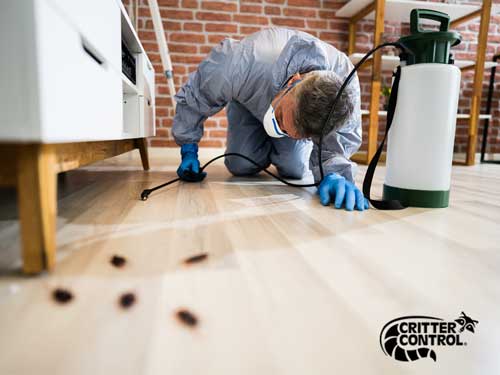Specialist A1 Charlotte Bed Bug Exterminator - Top Quality Solution Assured
Specialist A1 Charlotte Bed Bug Exterminator - Top Quality Solution Assured
Blog Article
Bed Insect Treatment Break Down: Comparing Chemical Vs. Non-Chemical Solutions
In the world of parasite control, particularly when handling the persistent problem of bed pests, the option between chemical and non-chemical treatment remedies can be an essential one. Both techniques offer distinctive advantages and disadvantages, influencing variables such as efficiency, safety considerations, and overall price. By analyzing the nuanced details of each technique, a clearer understanding of which path to go after in addressing a bed insect infestation can be acquired.
Performance of Chemical Treatments
Chemical treatments for bed insect problems have been widely recognized for their fast and potent effectiveness in eradicating these bugs. When thinking about the performance of chemical treatments, it is crucial to understand that they can give a extensive and quick option to a bed bug issue.
In addition, chemical treatments have the advantage of using recurring effects, implying that they can continue to remove bed insects also after the initial application. This recurring activity is specifically beneficial in combating any type of prospective re-infestations. Additionally, the fast action of chemical therapies can bring relief to individuals dealing with severe bed pest invasions, enabling them to gain back control of their living rooms swiftly.
Safety Interest In Chemical Solutions
When making use of chemical solutions for bed insect therapy is guaranteeing the safety of occupants and the setting,One critical facet that calls for careful consideration. While chemical treatments can be efficient in getting rid of bed bugs, they may pose risks otherwise managed appropriately. One of the primary safety and security interest in chemical solutions is the prospective harm they can cause to human health and wellness. Exposure to particular chemicals used in bed pest treatments can result in breathing problems, skin irritability, or various other damaging reactions, specifically in individuals with pre-existing conditions or sensitivities. Furthermore, improper application or dose of chemical pesticides can cause hazardous deposits lingering in the treated location, positioning long-term wellness threats to occupants.
Moreover, the ecological impact of chemical services is another substantial factor to consider. Some pesticides utilized in bed pest therapies may be damaging to helpful pests, wild animals, and ecological communities if they seep into the soil or water supply. It is necessary to make use of chemical therapies sensibly, following security standards, and considering much less toxic alternatives to minimize these dangers and make sure the safe and effective management of bed pest invasions.
Advantages of Non-Chemical Strategies
Considering the potential safety worries and ecological influence linked with chemical services for bed pest treatment, discovering non-chemical methods provides an encouraging alternative with several unique benefits. Non-chemical methods use a much safer choice for homes, especially those with individuals, pets, or children delicate to harsh chemicals. These techniques remove the risks of exposure to hazardous compounds, lowering the potential for negative wellness impacts. In addition, non-chemical therapies are environmentally friendly, as they do not contribute to air or water pollution, making them a lasting selection for bug control.
Furthermore, non-chemical services can be reliable in targeting bed bugs, including hard-to-reach areas where chemical therapies might not pass through. Techniques such as warm therapy, vacuuming, vapor cleaning, and cushion coverings provide thorough eradication without the use of hazardous chemicals. In addition, non-chemical approaches can be much less turbulent, calling for marginal preparation and permitting for quicker reentry into treated areas. Generally, choosing non-chemical bed bug therapy approaches not only prioritizes safety and security in pest control and environmental management but also makes certain extensive and efficient bug control.
Limitations of Non-Chemical Treatments

Additionally, non-chemical treatments commonly need several applications to attain successful eradication. This can be taxing and might not always guarantee complete removal of all bed pests and their eggs, specifically in hard-to-reach or hidden places.
Additionally, the success of non-chemical treatments greatly depends on correct application and thoroughness, which can be challenging for individuals without expert know-how. Insufficient application of non-chemical techniques might lead to incomplete elimination, resulting in relentless infestations and the need for extra treatments.
For that reason, while non-chemical therapies have their benefits, it is important to recognize these restrictions and consider them when figuring out the most reliable approach for taking care of bed pest invasions.
Price Comparison: Chemical Vs. Non-Chemical Options
Provided the limitations connected with non-chemical treatments, an essential facet to evaluate in the context of bed bug monitoring is the price comparison between chemical and certified pest control non-chemical choices. In comparison, non-chemical therapies like warmth treatment or vapor can be more expensive, with costs ranging from $1,000 to $6,000 for a whole home. While the first price of chemical treatments may appear lower, multiple treatments might be required to completely eliminate the infestation, possibly increasing the overall cost.
Verdict

Taking into consideration the potential security problems and ecological impact linked with chemical solutions for bed insect therapy, checking out non-chemical methods offers an appealing choice with several unique benefits.Provided the restrictions connected with non-chemical treatments, an essential element to assess in the context of bed bug administration is the cost comparison between chemical and non-chemical options. In contrast, non-chemical therapies like warm treatment or steam can be extra expensive, with expenses varying from $1,000 to $6,000 for an entire home. While the first expense of chemical treatments may seem reduced, several therapies may be required to fully eradicate the infestation, potentially boosting the total price.In final thought, when contrasting chemical and non-chemical bed bug therapy options, it is crucial to take into consideration efficiency, safety, advantages, limitations, and expense.
Report this page